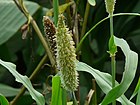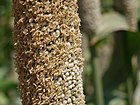Note: This is a project under development. The articles on this wiki are just being initiated and broadly incomplete. You can Help creating new pages.
Difference between revisions of "Pennisetum glaucum"
Chaithrika (talk | contribs) m (Chaithrika moved page Pearl millet(Navane) to Pennisetum glaucum: renaming as per convention) |
|||
| (6 intermediate revisions by 3 users not shown) | |||
| Line 1: | Line 1: | ||
| − | [[File:Pennisetum glaucum | + | [[File:Pennisetum glaucum (4657009324).jpg |thumb|right|'''Pennisetum glaucum''']] |
| + | '''Pennisetum glaucum''' is the most widely grown type of millet. It has been grown in Africa and the Indian subcontinent since prehistoric times. The center of diversity, and suggested area of domestication, for the crop is in the Sahel zone of West Africa. | ||
| + | ==Uses== | ||
| + | {{Uses|Tonic}}, {{Uses|Heart diseases}}. | ||
| + | ==Parts Used== | ||
| + | {{Parts Used|Fruits}}. | ||
| − | + | ==Chemical Composition== | |
| + | It contains similar amounts of Ca and P and more Fe. | ||
| + | <ref name="chemical composition"/> | ||
| + | ==Common names== | ||
| + | {{Common names|kn=ಸಜ್ಜೆ/ಕಂಬು Sajje/kambu|ml=Kambam|sa=|ta=Kambu|te=Sajjalu|hi=Bajra|en=Candle millet, Dark millet}} | ||
| − | == | + | ==Properties== |
| + | Reference: Dravya - Substance, Rasa - Taste, Guna - Qualities, Veerya - Potency, Vipaka - Post-digesion effect, Karma - Pharmacological activity, Prabhava - Therepeutics. | ||
| + | ===Dravya=== | ||
| − | + | ===Rasa=== | |
| − | + | ===Guna=== | |
| − | + | ===Veerya=== | |
| − | + | ===Vipaka=== | |
| − | + | ===Karma=== | |
| − | + | ===Prabhava=== | |
| − | + | ==Habit== | |
| + | {{Habit|Herbs}} | ||
| − | + | ==Identification== | |
| + | ===Leaf=== | ||
| + | {{Leaf|Simple|Linear in outline|5-10.0 cm long and as broad}}<ref name="Leaf"/> | ||
| − | |||
| − | + | ===Fruit=== | |
| + | {{Fruit|Simple Fruit|Ovoid|3 – 4 mm length|White, Pale yellow, Brown, Grey, Slate blue or Purple|1000-seed more}} | ||
| − | + | ===Other features=== | |
| − | + | ==List of Ayurvedic medicine in which the herb is used== | |
| − | == | + | ==Where to get the saplings== |
| + | ==Mode of Propagation== | ||
| + | {{Propagation|Seeds}}. | ||
| − | + | ==How to plant/cultivate== | |
| − | + | Pearl millet is well adapted to growing areas characterized by drought, low soil fertility, and high temperature. It performs well in soils with high salinity or low pH.<ref name="How to plant/cultivate"/> | |
| − | |||
| − | == References == | + | ==Commonly seen growing in areas== |
| + | {{Commonly seen|Grass Land}}. | ||
| + | |||
| + | ==Photo Gallery== | ||
| + | <gallery class="left" caption="" widths="140px" heights="140px"> | ||
| + | File:Pennisetum glaucum (2789788742).jpg | ||
| + | File:Pennisetumglaucumgrain.jpg | ||
| + | File:Pennisetum glaucum (4656388977).jpg | ||
| + | </gallery> | ||
| + | |||
| + | ==References== | ||
<references> | <references> | ||
| − | <ref name=" | + | <ref name="chemical composition">[https://acsess.onlinelibrary.wiley.com/doi/abs/10.2135/cropsci1972.0011183X001200020009x Chemical composition]</ref> |
| + | |||
| + | <ref name="Leaf">[https://en.wikipedia.org/wiki/Pearl_millet Morphology]</ref> | ||
| + | |||
| + | <ref name="How to plant/cultivate">[https://en.wikipedia.org/wiki/Pearl_millet Cultivation Details]</ref> | ||
</references> | </references> | ||
| + | |||
| + | ==External Links== | ||
| + | * [https://books.ub.uni-heidelberg.de/propylaeum/reader/download/180/180-30-76304-1-10-20161130.pdf Pennisetum glaucum on books.information] | ||
[[Category:Herbs]] | [[Category:Herbs]] | ||
| + | [[Category:Poaceae]] | ||
Latest revision as of 17:05, 29 June 2020
Pennisetum glaucum is the most widely grown type of millet. It has been grown in Africa and the Indian subcontinent since prehistoric times. The center of diversity, and suggested area of domestication, for the crop is in the Sahel zone of West Africa.
Contents
- 1 Uses
- 2 Parts Used
- 3 Chemical Composition
- 4 Common names
- 5 Properties
- 6 Habit
- 7 Identification
- 8 List of Ayurvedic medicine in which the herb is used
- 9 Where to get the saplings
- 10 Mode of Propagation
- 11 How to plant/cultivate
- 12 Commonly seen growing in areas
- 13 Photo Gallery
- 14 References
- 15 External Links
Uses
Parts Used
Chemical Composition
It contains similar amounts of Ca and P and more Fe. [1]
Common names
| Language | Common name |
|---|---|
| Kannada | ಸಜ್ಜೆ/ಕಂಬು Sajje/kambu |
| Hindi | Bajra |
| Malayalam | Kambam |
| Tamil | Kambu |
| Telugu | Sajjalu |
| Marathi | NA |
| Gujarathi | NA |
| Punjabi | NA |
| Kashmiri | NA |
| Sanskrit | |
| English | Candle millet, Dark millet |
Properties
Reference: Dravya - Substance, Rasa - Taste, Guna - Qualities, Veerya - Potency, Vipaka - Post-digesion effect, Karma - Pharmacological activity, Prabhava - Therepeutics.
Dravya
Rasa
Guna
Veerya
Vipaka
Karma
Prabhava
Habit
Identification
Leaf
| Kind | Shape | Feature |
|---|---|---|
| Simple | Linear in outline | 5-10.0 cm long and as broad |
Fruit
| Type | Size | Mass | Appearance | Seeds | More information |
|---|---|---|---|---|---|
| Simple Fruit | Ovoid | 3 – 4 mm length | White, Pale yellow, Brown, Grey, Slate blue or Purple | 1000-seed more | {{{6}}} |
Other features
List of Ayurvedic medicine in which the herb is used
Where to get the saplings
Mode of Propagation
How to plant/cultivate
Pearl millet is well adapted to growing areas characterized by drought, low soil fertility, and high temperature. It performs well in soils with high salinity or low pH.[3]
Commonly seen growing in areas
Photo Gallery
References
External Links
- Ayurvedic Herbs known to be helpful to treat Tonic
- Ayurvedic Herbs known to be helpful to treat Heart diseases
- Herbs with Fruits used in medicine
- Herbs with common name in Kannada
- Herbs with common name in Hindi
- Herbs with common name in Malayalam
- Herbs with common name in Tamil
- Herbs with common name in Telugu
- Herbs with common name in English
- Habit - Herbs
- Index of Plants which can be propagated by Seeds
- Herbs that are commonly seen in the region of Grass Land
- Herbs
- Poaceae



